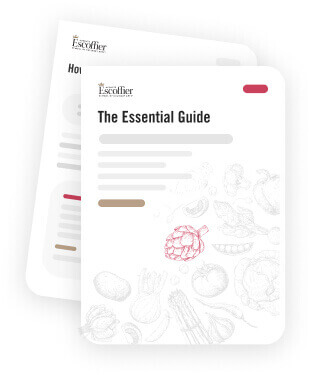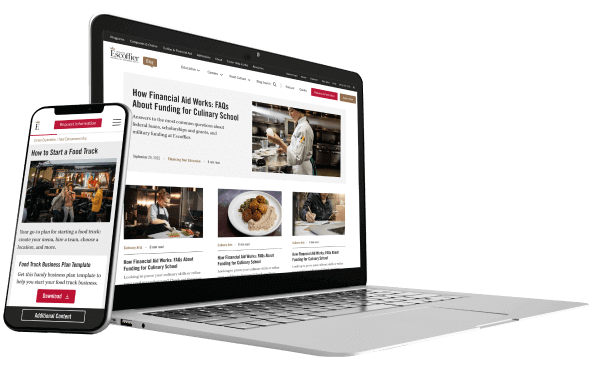Listen to This Article:
Nothing says comfort food quite like a warm, juicy slice of roast beef served with mashed potatoes and pan juices. But did you know that how you cut your beef cuts can make or break the success of your presentation?
Carve your roast incorrectly, and your slices of meat could be too fatty, tougher than your customers would like, or too dry.
This is your beef-cutting guide for how to correctly carve three of the most common beef cuts: beef tenderloin, prime rib roast, and corned beef.
Preparation for Beef Carving: The Tools You Need
Once you have a well-cooked and rested cut of beef, it’s time to gather your tools. Chefs often use the following essential items for carving roast beef:
- A wooden cutting board, ideally with a moat to gather any juices. Never cut your roast in a metal or ceramic roasting pan as this will dull your knife!
- A meat fork to stabilize the roast while carving
- A sharpening stone or honing rod
- A sharp carving knife
Most chefs will touch up their carving knife with the honing rod or sharpening stone before delving into carving. A sharpened knife will produce the cleanest, best-looking slices of beef.
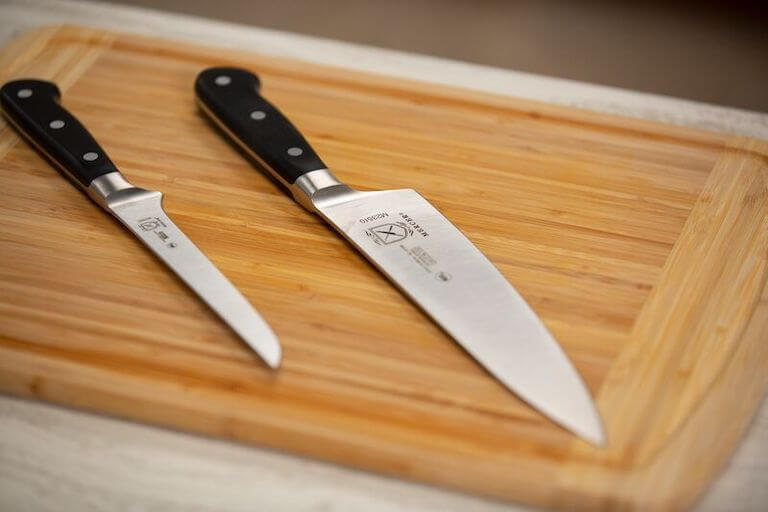
A sharp knife and a wooden cutting board with a moat are essential tools for carving beef.
How to Carve Your Beef Roasts
Now that you have all your tools assembled, it’s time to get cutting! Each beef cut has a few specific techniques to work with, but there are a few general rules of thumb.
1. Carve Your Beef Against the Grain
The muscle fibers in the roast will all be running in one direction. In general, you want to carve your beef by cutting across the grain, because this makes the slices more tender for chewing.
2. Cut Your Slices to a Consistent Thickness
Though it may seem insignificant, serving perfectly consistent slices of meat is pleasing to the eye of the customer. The specifics will vary depending on the specific roast (See below).
3. Cut, Don’t Saw
If you’ve prepared your knife properly, you should be able to slice cleanly and easily through your beef. Slice with smooth, drawing strokes, but don’t “saw” at the beef. This will result in a ragged-looking slice that isn’t inspiring on the plate. Here are some specific tips for carving tenderloin roast, prime rib roast, and corned beef.
Carving Beef Tenderloin
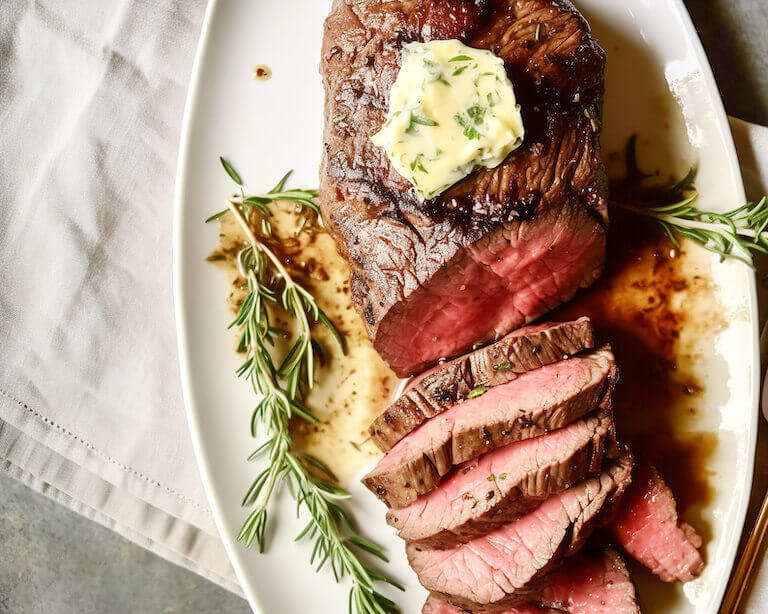
Carving Tenderloin is as simple as cutting across the grain into rounds.
Carving a tenderloin roast can be simple. After resting the meat, cut thin slices of tenderloin across the grain, ¼” to ½” thick, or carve them into “steaks” at whatever thickness you choose.
There will likely be flavorful juices remaining in the roasting pan. Dip each slice in the pan juices before arranging on plates or a serving platter. Then, use the pan drippings to make a gravy or “au jus” sauce by adding some white or red wine to deglaze your pan, and reduce to desired thickness.
Alternatively, you can add a little flour to make a roux and dilute with some broth or other liquid, or fatten the sauce up with a few dollops of butter before serving.
Carving Prime Rib Roast
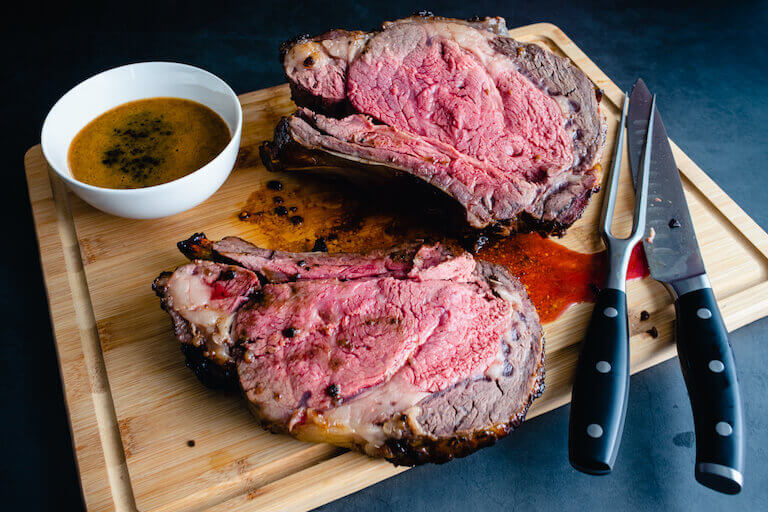
Slabs of prime rib roast are cut across the grain, and are often served au jus.
Remove the prime rib roast to a cutting board to rest, and cut away the strings. Allow to rest 20-30 minutes for the meat to absorb juices and reach its full temperature.
After resting, there are two ways to cut a prime rib roast. One option is to cut just inside the rib bones, and fold the roast away from the bones to remove. Then place the roast bone-side down and slice the roast against the grain to your desired thickness.
The other option is to use the English method. Remove the ribs, carve off a flat surface on one end of the roast, stand the roast on that end, and then carve slices off the top.
Arrange the slices on a plate or serving platter, and douse with pan-dripping gravy.
Carving Corned Beef
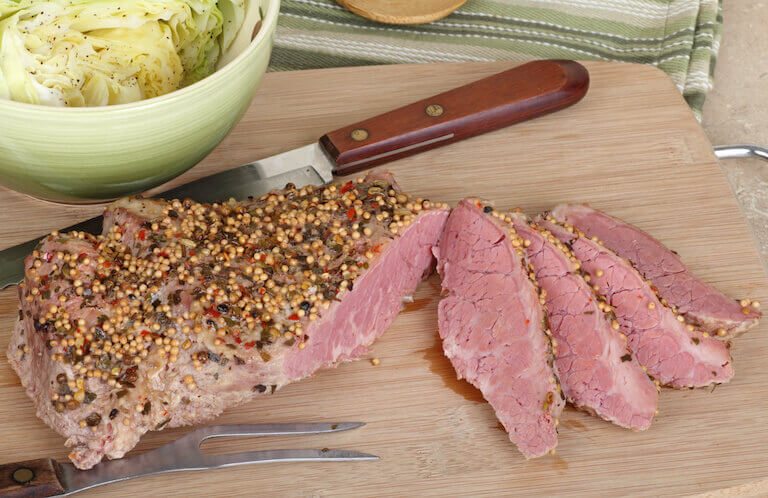
Corned beef is simply carved across the grain in thin slices.
Corned beef has no bones, and very little fat, and the brisket is usually a wide, flat cut of meat, so carving it is simple. Place the corned beef cut onto a cutting board. Remove any truss strings. Carve across the grain into thin slices. Corned beef is often served with boiled cabbage.
Understanding the Different Beef Cuts
All the fancy names for beef cuts simply tell you what part of the cow the meat came from. Each cut has its own unique texture and flavor, and certain cuts are essential for an authentic dish. For example, a pot roast is generally going to come from the chuck, or shoulder, or the round, which is the rump.
For ideal roast beef results, you need to start with the right cuts and prepare them properly.
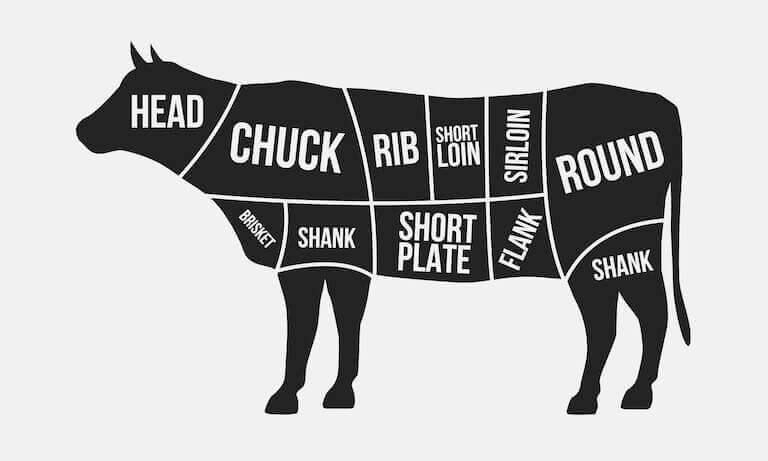
Cuts of beef are named for the part of the cow they come from.
Tenderloin Roast
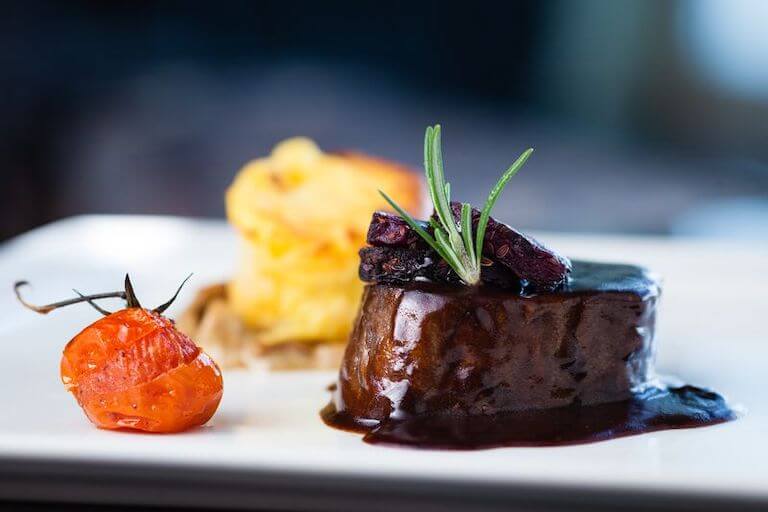
The tenderloin roast is one of the most delectable cuts of beef, and comes from near the rear spine of the cow.
A tenderloin roast comes from the “loin” or backstrap of the beef, cut from alongside the spine near the rear of the cow. This cut is also known more commonly as the filet of filet mignon. Revered for its tenderness and flavor, the tenderloin is melt-in-your-mouth tender because there is very little connective tissue in the cut.
A tenderloin roast is boneless, and is a long, cylinder-shaped piece of meat. Tenderloin is prepared for roasting by shaving all but a thin layer of fat, trimming to make the roast a consistent width, and tying it up with butcher’s twine around its girth.
Standing or Prime Rib Roast
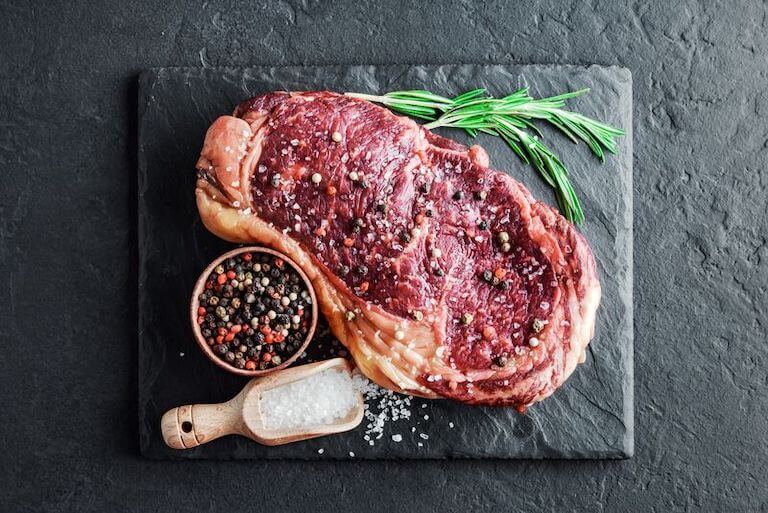
The prime rib roast has large medallions of meat to prepare into luscious slices of roast beef.
The standing rib or prime rib roast, popular for holidays and special occasions, is cut from the mid-flank of the cow in the rib area, between the chuck, which is the shoulder area, and the short loin area which is more toward the back end of the cow. A prime rib roast often makes a dramatic statement on the serving platter, with the rib ends poking out of a perfectly browned outer shell.
Prime rib can be bone-in or boneless. This area of the cow has strong marbling, or fat running throughout, which makes the meat juicy and flavorful.
What Does “Prime” Rib Mean?
“Prime” refers to the larger divisions of the carcass, such as the front quarter or hind quarter. Those sections are then subdivided into more specific “subprimal” cuts, like “short loin” or the “brisket plate”. Finally, the subprime cuts are portioned out for individual servings or for retail sale to consumers. So prime rib means that the roast is a main segment taken from the rib area near the spine of the cow.
Prime should not be confused with “USDA Prime” which is a grade given during inspection to suggest the meat is of the highest quality. USDA grading considers the health and age of the cow, marbling, and tenderness.
Corned Beef
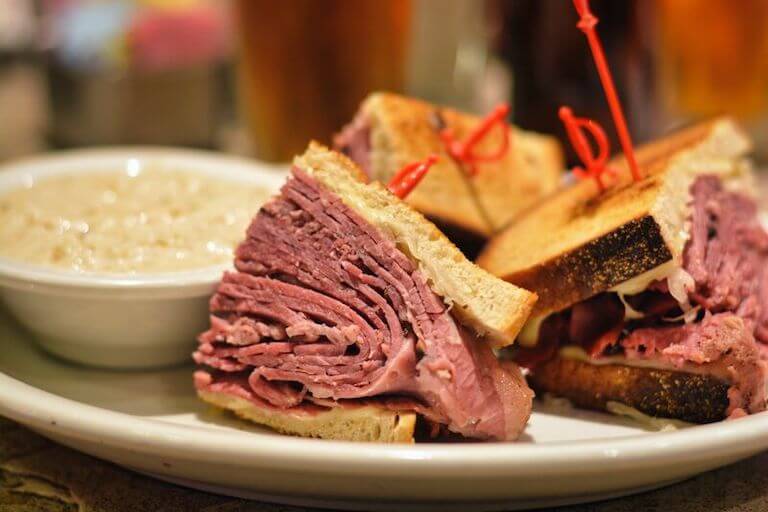
Corned beef is made from brined and spiced brisket, and it makes a classic sandwich component.
Corned beef is traditionally made from the brisket flat, which is a boneless cut of meat just above the front legs on the shoulder.
Corned beef is prepared by first curing the brisket with large-grain rock salt and spices in a process that takes a few weeks. Once the brining is complete, corned beef is usually boiled or simmered for an extended period, which makes it tender and flavorful.
Roast Prep Instructions
Each of the three roasts has a slightly different preparation. Here’s how to prepare your roasts for ideal carving at the end:
Tenderloin Roast
Trim off the thin layer of surface fat, and trim the meat to make the roast an even width. Truss with butcher’s twine at even intervals along the roast. Roast fat side up.
Prime Rib Roast
Trim the fat down to a ¼” layer all the way around, and tie the roast with twine between each rib. Sometimes, this cut is already prepared like this by the butcher. Place roast fat side up for cooking.
Corned Beef
Julia Child shares this recipe in The Way to Cook: Rub a full-sized (10+ pound) brisket with 1 and 1/3 cup coarse salt, 1 Tbsp peppercorns, 2 tsp each allspice and thyme, and 1 tsp each paprika, sage, and bay leaf. Place in a plastic bag, and place in a bowl in the refrigerator with a weight on top. Once a day for 2 weeks, massage the meat without opening the bag and turn over. Once cured, de-salt by soaking in 2-3 changes of fresh cold water over a few days.
Ideal Cooking Temperature for Beef Roasts
Getting the cooking temperature just right for your roast beef will ensure delicious flavor and tenderness. Depending on your preferred doneness, here are the recommended temperatures from French cooking expert Julia Child:
- For Tenderloin Roast: 120 degrees for rare, 125 degrees for medium rare
- For Roast Prime Rib: 120 degrees at the large end for rare, 125-130 for medium rare, 140 for medium.
- Corned beef will be quite well cooked after the recommended cooking time of three to four hours of simmering.
Once your preferred cooking temperature is reached, the meat must rest. Many cooks are impatient to skip this step, but the pros know that there’s no substitute for resting.
There are two reasons to rest meat after cooking. Resting allows the meat juices to soak into the muscle fibers, keeping the meat moist for serving. It also allows the meat to come to its full cooking temperature. Meat continues to rise five to ten degrees in temperature after you remove it from heat.
A Few More Tips for Perfect Beef Carving
Though resting is probably the most important tip for making your roast beef juicy and delicious, here are a few other important tips for having perfect beef.
- Make sure your knife is well-sharpened. A sharp blade helps your meat slices look tidy and presentable.
- If your meat is on the tougher side, cut thinner slices for easier eating.
- Experiment with the amount of fat trimming you do prior to roasting until you get just the right amount for flavor and moisture.
How You Can Advance Your Culinary Skills
If you love all things carnivore and enjoy carving beef roasts and racks of lamb, a culinary education at Auguste Escoffier School of Culinary Arts could help you bring your meat skills to the next level.
With several online and in-person programs to choose from, a degree in culinary arts could help you find the professional path that’s best for you. Consider Escoffier’s culinary diploma or degree programs either online or from our ground campuses in Colorado and Texas.
Reach out to our admissions team to learn more about what’s possible for you on your culinary journey.
IF YOU LOVED THIS ARTICLE ABOUT BEEF CARVING, CONSIDER READING THESE ARTICLES NEXT:
- How to Make Corned Beef Hash and Eggs
- Different Knives and the Best Uses for Them
- 4 Tips for Cooking With Bison
*Information may not reflect every student’s experience. Results and outcomes may be based on several factors, such as geographical region or previous experience.
